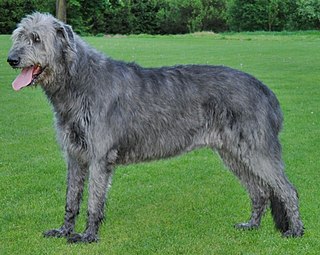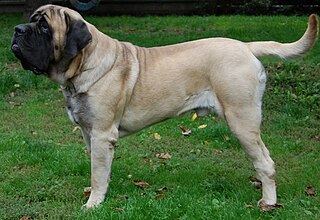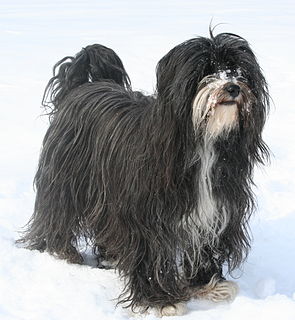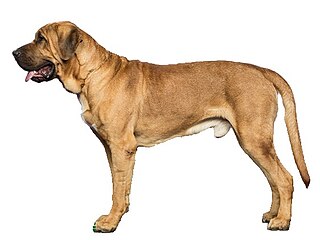See also
| Wikinews has related news: |
| Tibetan Kyi Apso | |||||||||||||||||||||||||
|---|---|---|---|---|---|---|---|---|---|---|---|---|---|---|---|---|---|---|---|---|---|---|---|---|---|
| Origin | Tibet (China) | ||||||||||||||||||||||||
| Breed status | Not recognised as a breed by any major kennel club. | ||||||||||||||||||||||||
| |||||||||||||||||||||||||
| Dog ( domestic dog ) | |||||||||||||||||||||||||
The Tibetan Kyi Apso is a breed of livestock guardian dog from Tibet. [1] [2] [3] In Tibet, the Pashmina of this breed is occasionally saved and used to weave small carpets. [4]
In comparison to the Tibetan Mastiff, the Kyi Apso has a bearded, shaggy muzzle and longer hair overall but also its bone is not as hefty. Most Kyi Apsos appear lighter and more athletic than a Tibetan Mastiff, and lack the huge, sagging lips or dewlaps, facial wrinkles, or a lot of haw. [4]
Considered a primitive breed, it typically retains the hardiness which would be required for it to survive in Tibet and the high-altitude Himalayan range. [5]
As a flock guardian dog in Tibet and in the West, it uses all the usual livestock guardian tactics (e.g., barking, scent-marking perimeters) to warn away predators and avoid direct confrontations. [4]
The earliest mention of this dog breed comes from writings in the 19th and early 20th centuries about dogs from Central Asia, Tibet and the Himalayan countries. It is related to the Tibetan Mastiff. [4]
Captain George Augustus Graham, best known among dog fanciers as the founder of the Irish Wolfhound Club of Great Britain, imported a dog called a "Tibetan wolf dog". [6] This dog is best described as a Kyi Apso. [7]
The 13th Dalai Lama is noted to have owned a dog of this type. [8]
Relatively few Tibetan Kyi Apsos have reached North America or Europe. Among the first to North America were imported in the late 1970s, or perhaps earlier, but none of those dogs seem to have left any progeny. [4]
The breed used to be well-represented and cared for by the now-defunct Tibetan Kyi Apso Club, which was established in 1995, but it collapsed in 1999 and registered no litters after 2000.
| Wikinews has related news: |

The Irish Wolfhound is a historic sighthound dog breed from Ireland that has, by its presence and substantial size, inspired literature, poetry and mythology. Like all sighthounds, it was used to pursue game by speed; it was also famed as a guardian dog, specializing in protection against and for the hunting of wolves. The original dog-type was presumed extinct by most knowledgeable authors but recreated specifically for the canine fancy mainly by Captain George A. Graham in the late 19th century. The modern breed, classified by recent genetic research into the Sighthound United Kingdom Rural Clade, has been used by coursing hunters who have prized it for its ability to dispatch game caught by other, swifter sighthounds.

A dog breed is a particular strain or dog type that was purposefully bred by humans to perform specific tasks, such as herding, hunting, and guarding. When distinguishing breed from type, the rule of thumb is that a breed always "breeds true". Dogs are the most variable mammal on earth, with artificial selection producing around 450 globally recognized dog breeds. These breeds possess distinct traits related to morphology, which include body size, skull shape, tail phenotype, fur type, and coat colour. Their behavioural traits include guarding, herding, and hunting, and personality traits such as hypersocial behavior, boldness, and aggression. Most breeds were derived from small numbers of founders within the last 200 years. As a result, today dogs are the most abundant carnivore species and are dispersed around the world.

The Great Dane is a German breed of domestic dog known for its large size.

The Bullmastiff is a large-sized breed of domestic dog, with a solid build and a short muzzle. The Bullmastiff is mastiff type dog, and was originally developed by 19th-century gamekeepers to guard estates. The breed was created by crossing the English Mastiff with the now extinct Old English Bulldog. It was recognized as a purebred dog by the English Kennel Club in 1924.

The Shih Tzu is a toy dog breed, weighing from 4 to 7.25 kilograms (9–18lb) when fully grown. The breed was developed in Tibet.

A working dog is a dog used to perform practical tasks, as opposed to pet or companion dogs.
Toy dog traditionally refers to a very small dog or a grouping of small and very small breeds of dog. A toy dog may be of any of various dog types. Types of dogs referred to as toy dogs may include spaniels, pinschers and terriers that have been bred down in size. Not all toy dogs are lapdogs, although that is an important and ancient type of toy dog.

A mastiff is a large and powerful type of dog. Mastiffs are among the largest dogs, and typically have a short coat, a long low-set tail and large feet; the skull is large and bulky, the muzzle broad and short (brachycephalic), and the ears drooping and pendant-shaped. European and Asian records dating back 3,000 years show dogs of mastiff type. Mastiffs have historically been guard dogs, protecting homes and property, although throughout history they have been used as hunting dogs, war dogs and for blood sports, fighting each other and such animals as bears, lions and bulls.

The Lhasa Apso is a non-sporting dog breed originating in Tibet. It was bred as an interior sentinel in the Buddhist monasteries, to alert the monks to any intruders who entered. Lhasa is the capital city of Tibet, and apso is a word from the Tibetan language. There is some debate over the exact origin of the name; some claim that the word "apso" is an anglicized form of the Tibetan word for goatee or perhaps "ra-pho" (ར་ཕོ་) meaning "billy goat". It may also be a compound noun meaning "bark-guard".

The Tibetan Mastiff is a large Tibetan dog breed belonging to the mastiff family. Its double coat is long, subject to climate, and found in a wide variety of colors, including solid black, black and tan, various shades of red and bluish-gray, often with white markings.

The Anatolian Shepherd or Anadolu çoban köpeği is a livestock guardian dog breed that originated in the peninsula of Anatolia, which today forms a large portion of Turkey. The Anatolian Shepherd is rugged, large, and very strong, with good sight and hearing that allow it to protect livestock. With its high speed and agility, it is able to run down a predator with great efficiency. Historically, the Anatolian Shepherd has been treated and categorized as a separate breed from the Kangal Shepherd Dog by many canine registries, but is now generally regarded as part of the same breed population.

The Mastiff is a breed of large dog. National kennel clubs, including the United Kingdom's Kennel Club and the American Kennel Club, refer to the breed as simply the Mastiff. The Mastiff was archaically referred to as the Old(e) English Mastiff. They perhaps descended from the ancient Alaunt and Pugnaces Britanniae, with a significant input from the Alpine Mastiff in the 19th century. Distinguished by its enormous size, massive head, short coat in a limited range of colours, and always displaying a black mask, the Mastiff is noted for its gentle and loving nature. The lineage of modern dogs can be traced back to the early 19th century, but the modern type was stabilised in the 1880s and refined since. Following a period of sharp decline, the Mastiff has increased its worldwide popularity. Throughout its history the Mastiff has contributed to the development of a number of dog breeds, some generally known as mastiff-type dogs, or, confusingly, just as "mastiffs".

The Tibetan Terrier is a medium-size breed of dog that originated in Tibet. Despite its name, it is not a member of the terrier group. The breed was given its English name by European travelers due to its resemblance to known terrier breeds. The Tibetan name for the breed, Tsang Apso, roughly translates to "shaggy or bearded ("apso") dog, from the province of Tsang". Some old travelers' accounts refer to the dog as Dokhi Apso or "outdoor" Apso, indicating a shaggy or bearded working dog which lives outdoors.

The Tosa is a breed of dog of Japanese origin that is considered rare. It was originally bred in Tosa, Shikoku as a fighting dog and is the only breed still used (legally) in Japanese dog fighting. Ownership is restricted in some countries as a dangerous breed.

The Broholmer, also called the Danish Mastiff, is a large Molosser breed of dog from Denmark, recognized by the Danish Kennel Club and the Fédération Cynologique Internationale. It has been employed as a guard dog in the homes of the wealthy. The breed's numbers dwindled severely during World War II, but the dog made a successful return in the 1970s.

The Bhotia, also known as the Himalayan sheepdog or the Himalayan mastiff, is a breed of livestock guardian dog from India and Nepal.

The Alpine Mastiff is an extinct Molosser dog breed, the progenitor of the St. Bernard, and a major contributor to the modern Mastiff, as well as to other breeds that derive from these breeds or are closely related to them. M.B. Wynn wrote, "In 1829 a vast light brindle dog of the old Alpine mastiff breed, named L'Ami, was brought from the convent of Great St. Bernard, and exhibited in London and Liverpool as the largest dog in England." William Cavendish, 5th Duke of Devonshire, is believed to have bred Alpine Mastiffs at Chatsworth House.

Armenian Gampr is a landrace breed native to the Armenian Highlands. It sits within the Ovcharka group of livestock guardian dogs which can be found throughout the Transcaucasus area.
The Intelligence of Dogs is a 1994 book on dog intelligence by Stanley Coren, a professor of canine psychology at the University of British Columbia in Vancouver. The book explains Coren's theories about the differences in intelligence between various breeds of dogs. Coren published a second edition in 2006.